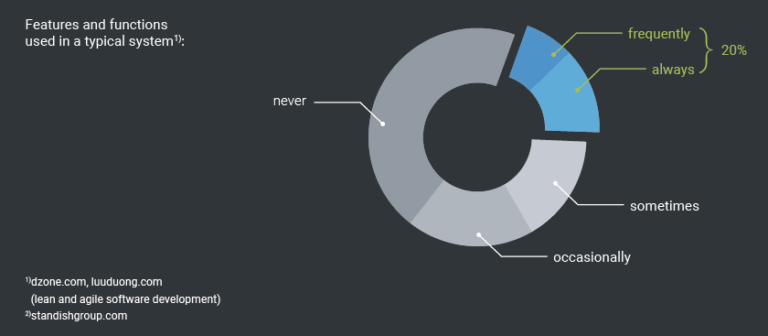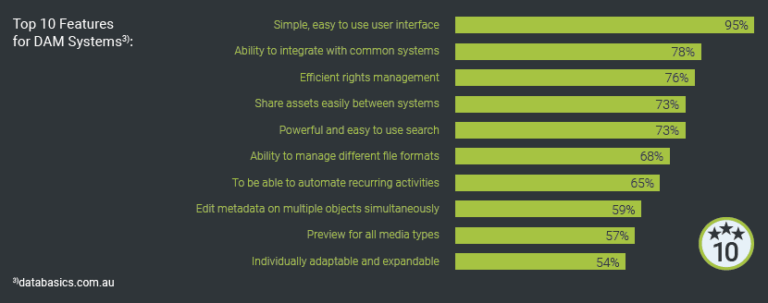
Software development: What do you really need?
Software development is shaped by the conflict between time, money, and scope. That’s why it is also called the “project triangle”. If one pulls on one corner of the triangle, the proportions of the sides shift accordingly. For example, you can increase the scope of a new product by investing more time in its development. However, this inevitably results in an increase in development costs. It is obvious that conflicts between the target parameters can hardly be avoided. The art of product management is to identify and contain them as early as possible through appropriate measures.
The project triangle is of course also used when launching a new software product. The strategic goal is to provide the first releases with functions that are most needed by customers as quickly as possible. After all, a new product does not yet earn money during the development period, it is rather a bet on the future. The earlier a software product can prove its value to customers, the faster it will achieve the corresponding return on investment (ROI).
Utility over quantity
Businesses frequently ask their customers whether they would like to have a particular function. The answer to such a question, however, can only ever be “yes”, although it is not yet possible to say exactly whether one really needs it. How would you know today whether you might need the “print website now” button in the future – for example, because you want to proofread content that way?
Of course, it is not quite as simple as that. But it is much more useful if you ask when or how often a function is used. Here, less a description of the use case as such is meant (a good product owner should know that anyway), but rather the information whether the user uses a feature daily, rarely or not at all. For a company developing new software, this information is invaluable.
80:20 – The Pareto Principle in software development
But is it really enough to concentrate on a few functions first? What about the endless checklists and volume-filling requests when it comes to procuring new software? Wouldn’t a new product be hopelessly outmatched by the top players?
If both parties did their homework, most likely not. Obviously, the procuring company needs to know exactly which functions will create the greatest added value for users, while the newcomer must cover as much of this requirement area as possible with its feature set.
In many businesses, 80 % of sales come from 20 % of customers. This business management insight was also applied to the software sector. Experts discovered that they could meet 80 % of business requirements if they developed 20 % of the functions with the highest priority. In this context, one also speaks of the so-called Pareto Principle.

A study by the Standish Group has shown that in typical software systems, 64 % of the functions are never or very rarely used in reality and 16 % are used only occasionally. On the other hand, 20 % of the functions are used always or frequently.
So why should one work through the feature lists of products available on the market, develop “nice to have” features or serve short-term hype topics and thus invest time and effort in functions that are never or only very rarely used? Isn’t it much more target-oriented to focus on the 20 % of features that really add value?
To develop what customers need every day
With vjoon seven, a state-of-the-art platform that is clearly focused on user needs is now entering the DAM stage. The advantage for newcomers is that they can work with state-of-the-art technologies and insights. Nowadays, many components do not have to be tediously developed in-house – it can be much more efficient to use modern, modular technologies that are freely available on the market. In the end, this benefits both manufacturers and users. For example, the number of open source components is growing continuously and many of them are being developed and driven forward in large projects.
This also applies to Kubernetes, which is used in vjoon seven. The system for providing, managing, and monitoring a container environment, which was developed by Google as open source software, has since become established as a standard. The advantages of applications that rely on Kubernetes are apparent: Kubernetes accelerates the provision of new functions, improves the resilience of infrastructures and increases automation in the construction, operation and maintenance of production environments.
Older, established systems often struggle with obsolete technical components and high complexity. Training, maintainability and the rollout of new functions drive up costs over the years and some people prefer to use a newer system, even or especially if the range of functions initially only concentrates on the value-adding 20 % of the previously available functions. The crucial question is, of course: What functions are these? The survey results from databasics, a company with more than 20 years of expertise in the DAM sector, provide an initial basis for this. A larger survey of DAM users ended up with 10 of the most used functions.

It probably comes as no surprise that 95 % of respondents want a simple, easy-to-use, intuitive interface for their DAM solution. In addition to users who work with the system on a daily basis, a typical DAM system also has many users who work with it very little or infrequently – a simple, intuitive User Experience (UX) significantly increases user acceptance, reduces training costs, and makes the system more flexible to use in the enterprise. This is where the Google Material Design used in vjoon seven comes in, a UX design standard that is now widely used. It lets the user see immediately what areas of the site contain important or interactive information and what the interaction will do. In addition, there are numerous other elements and concepts that make optimal UX possible and are therefore found in vjoon seven.
In the second place, at 78 %, is the ability to integrate with common systems. Digital asset management has always been about the ability to integrate software into existing infrastructures in companies. This way, more users can work with the same content pool, as well as edit and distribute content within a team. This enables end-to-end workflows and increases both productivity and value creation throughout the enterprise. In order to best implement this aspect, modern platforms such as vjoon seven are developed according to the API First principle. An extensively documented REST API provides access to all of the platform’s functions, allowing its functionality to be significantly expanded and adapted to individual requirements. The decisive advantage for companies is that both third-party systems, such as Web CMS, PIM, marketing automation, e-commerce, and more, as well as their own developments, can be quickly integrated. This reduces effort and accelerates the time-to-market process.
These two aspects alone show the potential of choosing the right functions when planning new software. Placing the customer benefits in the foreground is in this respect not only a marketing hype but also serves as a fundamental element for a successful product. The answer to “What do you really need?” is thus not necessarily to be found in the solutions already on the market, but rather in the daily lives of customers.
Do you need more information on vjoon seven? Contact us here.

